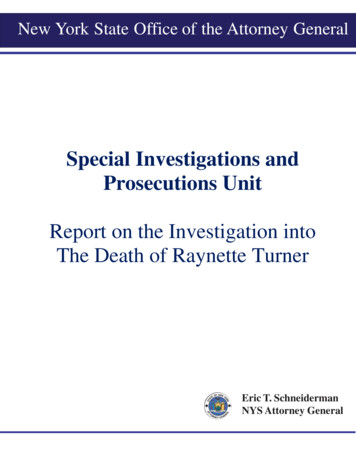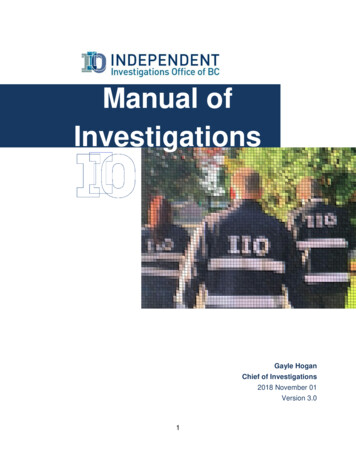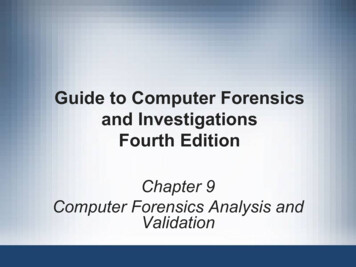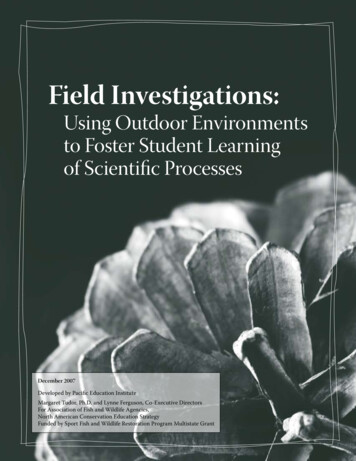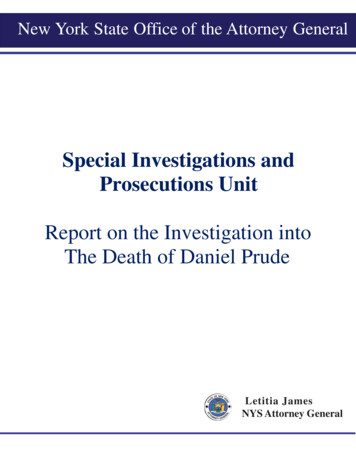
Transcription
New York State Office of the Attorney GeneralSpecial Investigations andProsecutions UnitReport on the Investigation intoThe Death of Daniel PrudeLetitia JamesNYS Attorney General
EXECUTIVE SUMMARYOn July 8, 2015, Governor Andrew Cuomo signed Executive Order 147, appointing theAttorney General as a special prosecutor “to investigate, and if warranted, prosecute certainmatters involving the death of an unarmed civilian . . . caused by a law enforcement officer.” OnMarch 30, 2020, Daniel Prude (“Mr. Prude”) died after becoming unresponsive during an incidentinvolving members of the Rochester Police Department (“RPD”). On July 15, 2020, GovernorCuomo issued Executive Order 147.35, expressly conferring jurisdiction on the Office of theAttorney General (“OAG”) to investigate any potential unlawful acts or omissions by lawenforcement related to Mr. Prude’s death.The OAG’s review of the facts and circumstances of this case were exhaustive and culminatedin the presentation of this matter to a Monroe County grand jury; the grand jury concluded itsbusiness on February 23, 2021. None of the factual information contained in this report was drawnfrom grand jury testimony or evidence obtained using grand jury subpoenas.On March 23, 2020, just before 3:00 A.M., Joe Prude, a resident of the City of Rochester,contacted 911 and reported that his brother, Daniel Prude, had run from Joe Prude’s home, wearingonly pants and a t-shirt, with no shoes. He also advised that his brother had been taken to StrongMemorial Hospital and released hours earlier and had been suicidal. When members of the RPDarrived at Joe Prude’s house in response to the 911 call, Joe Prude advised that his brother was on“PCP,” which Patrol Officer Mark Vaughn (“PO Vaughn”) broadcasted over the air for respondingofficers to be aware of in case they encountered Daniel Prude.Daniel Prude traveled one mile on foot in freezing weather conditions before being interceptedby members of the RPD. Between the time he left his brother’s house and the encounter with RPD,Mr. Prude was captured by a variety of surveillance cameras and his route and activities were latermapped. At one point during the route, he threw a brick through a computer store window andentered the store briefly before exiting, having stolen nothing, and continuing on. RPD officersresponded to the store and surmised that the person who had thrown the brick through the windowmight be the person they were looking for.In the meantime, Mr. Prude approached a tow truck driver on Jefferson Ave. “screaming” forhelp before running away after being told that help was coming; the tow truck driver called 911indicating that a man with “blood all over him” was running down Jefferson Ave. As Mr. Pruderan down the street, a young man, who had seen Mr. Prude engage with the tow truck driver, caughtup with and recorded him for the purpose of live streaming the encounter on social media. DuringMr. Prude’s recorded interaction with that man, which lasted roughly five minutes, he removedhis pants – the last item of clothing he was wearing – and remained naked for the duration of theincident.The young man’s live stream recording ended when PO Vaughn located Mr. Prude on JeffersonAve. and directed him to get on the ground and put his hands behind his back; Mr. Prude complied,and PO Vaughn applied handcuffs. Several other RPD officers arrived on scene and they waitedfor the arrival of an ambulance, which had been dispatched previously. None of the officers madeany attempt to connect with Mr. Prude, who grew more agitated. After Mr. Prude began spitting,1
the officers placed a spit sock over his head, which seemed to further agitate Mr. Prude. Aftershouting words to the effect of “Gimme your gun,” but while he remained naked, with his handscuffed behind his back, Mr. Prude moved in a way that, according to the officers, was leadingtoward him standing. At that point PO Vaughn, Patrol Officer Troy Taladay (“PO Taladay”), andPatrol Officer Francisco Santiago (“PO Santiago”) forced Mr. Prude to the ground and held himthere using a stabilization technique they had been taught at RPD in-service training, called“Segmenting.”An ambulance, staffed with a paramedic and an emergency medical technician (“EMT”)arrived on scene very shortly after Mr. Prude had been taken to the ground and while he was stillvery agitated, but their response to the situation appeared to lack urgency. The paramedic told theofficers, as they held Mr. Prude against the ground, that she was going to get something to calmMr. Prude, before circling back to ask questions to enable her to determine which sedative mightwork best; during this time, the EMT manipulated the gurney and brought it close to Mr. Prude,but did not check on him or interact with him or the officers. In the meantime, Mr. Prude fell silentand vomited.PO Vaughn noticed that Mr. Prude did not appear to be breathing and the officers rolled himto his side. The EMT joined the officers at that point and checked Mr. Prude for a pulse; not findingone, he called for the paramedic. The paramedic directed that the EMT begin CPR; several minuteslater, after the application of medical intervention, Mr. Prude recovered a pulse, but he neverregained consciousness. On March 30, 2020, Mr. Prude was removed from life support.The Monroe County Medical Examiner, Dr. Nadia Granger, performed an autopsy, ultimatelydeeming the “Manner of Death” a “homicide,” meaning that, for medical purposes, Mr. Prude’sdeath had occurred at the hands of another. She determined the causes of death to be:-Complications of asphyxia in the setting of physical restraint;Excited delirium; andAcute phencyclidine intoxication.These findings are addressed fully, within the report.The OAG retained an expert in restraint-related death, Dr. Gary Vilke, to review and, ifpossible, elaborate on the cause of Mr. Prude’s death. Dr. Vilke, agreed with many of theconclusions reached by Dr. Granger, although he opined that Mr. Prude suffered a cardiac arrest,which then caused a lack of oxygen to his brain, whereas Dr. Granger said she could not knowwhether Mr. Prude suffered cardiac arrest followed by respiratory arrest or if Mr. Prude’s heartstopped beating after he stopped breathing. Neither physician, however, found any evidence oftrauma that might accompany blockage of the windpipe or occlusion of a blood vessel. Dr. Vilkeopined that Mr. Prude’s ingestion of PCP precipitated a medical condition that he (and the MedicalExaminer and the paramedic) deemed “Excited Delirium.” He noted that people suffering withthis medical condition are particularly vulnerable to death by cardiac arrest (as did the MedicalExaminer), and he further concluded that it was this – cardiac arrest - that ultimately caused Mr.Prude’s death.2
The OAG further retained an expert in police procedures and use of force, Geoffrey Alpert,PhD, to opine as to the officers’ conduct in restraining Mr. Prude and the techniques used. Hisassessment, upon reviewing the evidence in the matter, including the officers’ training, was thatplacing the spit sock over Mr. Prude’s head, taking him to the ground, and performing the“segmenting” maneuver, were all within the scope of reasonable (although not necessarily the best)police practices under the circumstances. He did, however, opine that the officers’ conduct in notrolling Mr. Prude over from the prone position, particularly after he vomited, was contrary toacceptable police practice.As noted previously, the OAG placed this matter before a grand jury. This report was preparedbefore any vote was taken so that, if that no charges were returned against any officer, the publiccould be provided with details as to what took place in this case. We present a “LEGALPRINCIPLES” section, to discuss broadly some of the general legal issues presented in this typeof case.***Executive Orders 147 and 147.35 also provide that the OAG may offer “any recommendationsfor systemic reform arising from this investigation.” The OAG recommends that:I.Law Enforcement Officers, Emergency Communications Providers (Dispatchers), andEmergency Medical Service Personnel Must be Trained to Recognize the Symptomsof Excited Delirium Syndrome and to Respond to it as a Serious Medical Emergency;II.New York Should Mandate De-Escalation Training for all Police Officers, and PoliceAgencies Should Reflect a Commitment to De-Escalation in their Use of ForcePolicies;III.All Communities Should Assess Models for Responding to Crisis Situations thatMinimize or Eliminate Police Responses to Mental Health Calls Whenever Possible;Passing “Daniel’s Law” Would Greatly Aid in this Endeavor;IV.Law Enforcement Agencies Should Explore the Use of Spit Sock Alternatives;V.Data-Driven Analysis Should be Used to Determine the Most Effective DefensiveTactics (“DT”) Programs; andVI.The City of Rochester should Adopt a Body Worn Camera Release Policy RegardingCritical Incidents.3
FACTSNOTE: Any evidence disclosed in this report was obtained independent of the grand jury process;sources include pre-grand jury interviews as well as material obtained without the use of grandjury subpoenas.Cheektowaga, New YorkOn March 21, 2020, 41-year-old Daniel Prude (“Mr. Prude”) boarded an Amtrak train inChicago, bound for Rochester, New York, in order to visit his brother Joe Prude, with whom heshared a close relationship. At approximately 9:00 A.M., on March 22, 2020, 1 at the Amtrak stationjust outside of Buffalo, New York, Mr. Prude was asked to disembark because he had beensmoking cigarettes onboard; he departed without issue. About 2.5 hours later, at a location threemiles away from the train station, Mr. Prude encountered members of the Cheektowaga PoliceDepartment (“CPD”).Much of Mr. Prude’s interaction with CPD officers was captured on body worn cameras(“BWC”), a portion of which is linked here. During his time with the officers, Mr. Prude did notappear agitated and he showed no indication that he failed to accurately perceive reality; hefollowed the conversation and answered all questions appropriately. It was approximately 35 F inCheektowaga at the time, and Mr. Prude was dressed in a heavy coat, suitable for the weatherconditions. Mr. Prude explained that he was trying to get to his brother’s house in Rochester, NewYork (located approximately 70 miles east of Cheektowaga) but that his phone had been stolen onthe train and he therefore had no way of contacting his brother. The officers asked Mr. Prude if hewanted them to take him to a local shelter and he said that he did. When asked if he was under theinfluence of anything, Mr. Prude said that he had consumed “a lot of beer” and was drunk.Unprompted, he added, “And I smoke a little PCP and marijuana every now and then.” The officersdid not follow up as to when Mr. Prude had last consumed those substances.The CPD officers took Mr. Prude to the Harbor House homeless shelter in the City of Buffalo.With the assistance of another police agency, CPD was able to locate and contact Mr. Prude’sbrother (Joe Prude) in Rochester. Joe Prude then traveled to Buffalo to pick his brother up fromthe shelter and brought Daniel Prude back to his house located on Child St. in the City of Rochester.1This incident occurred at the very beginning of the Covid-19 pandemic, a fact that loomed large over some aspectsof the events that followed.4
Rochester, New YorkMarch 22, 2020, The First 911 Call from Joe Prude’s HomeAt approximately 6:52 P.M. that evening, Joe Prude’s wife (“Ms. Prude”), called 911,requesting that a police officer and ambulance respond to her house for a “mental hygiene arrest.” 2She explained that her brother-in-law (Daniel Prude) had just arrived from Chicago, was “comingoff of leaf” 3 and hallucinating. According to Ms. Prude, Mr. Prude was not violent but needed tobe hospitalized as soon as possible. Mr. Prude, whom Ms. Prude said did not have a mental healthhistory, could be heard speaking incoherently in the background of the call.In response to the 911 call, four Rochester Police Department (“RPD”) officers arrived at JoePrude’s home. Their BWC footage was synchronized and offers a glimpse into Mr. Prude’s mentalstate before his encounter with different RPD officers several hours later. Mr. Prude’s affect wasclearly different than it had been earlier in the day in Cheektowaga; he appeared highly agitatedand was repeating statements of a paranoid nature. Throughout the incident, Mr. Prude said thatpeople were going to kill him and that he wanted to die, while praying to “Jesus Christ” and “theLord” throughout. He was never violent, however, and while he appeared to be experiencing amental health crisis, he complied with all directives and allowed the first officer on-scene tohandcuff him without incident. After an emergency medical technician (“EMT”) arrived, theofficers, the EMT, and Joe Prude led Mr. Prude from the house to the ambulance, again withoutissue and without the application of force.Mr. Prude advised the EMT that he had consumed PCP, marijuana, and alcohol. During thenine-minute ride to Strong Memorial Hospital (“Strong Hospital”), Mr. Prude was alert andoriented and knew where he was, but also spoke, unsolicited, about Jesus and wanting to seepresumably deceased relatives. He coughed, prompting members of the ambulance crew to placea medical (non-spit) mask over his face to guard against Covid-19. But other than some smallabrasions and an elevated heart rate, his physical condition was unremarkable. The EMT notedthat the ride was uneventful, and that Mr. Prude appeared to calm down between leaving hisbrother’s house and arriving at Strong Hospital.RPD Officer John LaClair (“PO LaClair”) followed the ambulance to Strong Hospital andprocessed paperwork for Mr. Prude’s Mental Hygiene Arrest (“MHA”). He, like the EMT, advisedthe OAG that Mr. Prude was far less agitated by the time he arrived at Strong Hospital than he hadbeen when he left his brother’s house. PO LaClair left Mr. Prude, who was by then no longer inan agitated state, in the care of Strong Hospital staff.Strong Memorial Hospital – First Visit (3-22-20)2Pursuant to New York Mental Hygiene Law § 9.41, “Any police officer may take into custody any person whoappears to be mentally ill and is conducting himself in a manner which is likely to result in serious harm to himself orothers. Such officer may [under those circumstances] remove [such person] to [a] hospital ”3According to Ms. Prude, the “leaf” that Mr. Prude had consumed was from Chicago and was a type of cigarettedipped in embalming fluid and phencyclidine (“PCP”). The most common vernacular terms for the type of preparationdescribed by Ms. Prude are “fry” and “wet.” See, e.g. Gilbert C, Baram M, Cavarocchi N. 2013 “Smoking Wet”.Respiratory Failure Related to Smoking Tainted Marijuana Cigarettes. [Tex. Heart Inst. J.] 40(1): C3568288/5
As noted above [fn2], New York Mental Hygiene Law (“MHL”) § 9.41 permits a police officerto take an individual into custody if that person is suffering from a mental illness that is likely toresult in serious harm to that person or others; PO LaClair took Mr. Prude into custody pursuantto that section of law. From there, MHL §§ 9.45 and 9.39 authorize designated hospitals to assessindividuals, such as Mr. Prude, in order to determine whether they have a mental illness which is,again, “likely to result in serious harm to [themselves] or others.” Significantly, MHL § 9.39(a)(2)permits admission of an individual to the hospital only after a staff physician has examined thatperson to confirm that the above prerequisite condition is met. Accordingly, Strong Hospital wasauthorized to receive Mr. Prude and assess him but was only permitted to admit him to the hospitalif, upon assessment, he was at that time found to present a likely risk of serious harm to himself orothers.Mr. Prude’s hospital records are confidential, and we therefore cannot divulge any medical orpsychiatric information contained therein. Presumably, hospital staff resolved the question ofwhether Mr. Prude continued to pose a likely risk of “serious harm to himself or others” in thenegative because, at 10:51 P.M., Strong Hospital discharged Mr. Prude back to the Child St. homeof his brother, Joe Prude. 4 According to Joe Prude, at 11:00 P.M. on March 22, 2020, about fourhours after his brother had been taken to the hospital in an ambulance, Mr. Prude returned to JoePrude’s house via medical taxi.The IncidentMarch 22, 2020, The Second 911 Call from Joe Prude’s HomeAccording to Joe Prude, after Mr. Prude returned from Strong Hospital, the two were sitting atthe kitchen table talking for quite some time. At nearly 3:00 A.M., however, Joe Prude said that hisbrother began acting very strangely and, without warning, ran out of the back door wearing nothingmore than a tank top and long-john pajama bottoms. The temperature in Rochester at the time wasbetween 32 F and 33 F.After he left his brother’s home, footage of Mr. Prude was captured on various city-operatedcameras, surveillance cameras, and one civilian’s cellphone; the piecing together of that footageenabled mapping of Mr. Prude’s movements after he left his brother’s house. The map belowshows, in the upper left, Joe Prude’s home and, in the lower right, the location where RPD officersintercepted and restrained Mr. Prude. Also displayed are the locations of a Metro PCS store, a towtruck, and the route of a person who recorded Mr. Prude on his cell phone as he livestreamed the4Without relating any information relative to this case, we learned that Strong Hospital has a standard procedure forassessing individuals brought to the hospital after MHA arrests. This includes a physical examination in the generalemergency room before the patient is examined in the Comprehensive Psychiatric Emergency Program (CPEP).Before a patient’s final risk assessment, the patient will have been seen by a CPEP social worker, a nurse(s), and othermedical professionals (including resident psychiatric physicians) in CPEP, all of whom must document theirinteractions with the patient and note the patient’s behavior and demeanor. The social worker will also contact thepatient’s family or close contact to ensure that a safety plan is in place before releasing the patient. Additionally, thepatient must submit to a drug screen. The drug screen panel in use at Strong Hospital does not include a test for PCP;every RPD officer and medical professional with whom we spoke agreed that PCP is seen very rarely in thisgeographic area. The assessing psychiatrist is the last person to examine a patient before making the final riskdetermination pursuant to MHL § 9.39(a)(2), and in addition to the psychiatrist’s own assessment, the doctor willreview the complete medical record of the others involved in the process.6
footage online; the relevance of each will become clear within this report. The total distancecovered by Mr. Prude was approximately one mile and the total amount of time between Mr. Prudeleaving his brother’s home and his encounter with the first RPD officer was approximately 20minutes. The OAG, combining various pieces of media involved (surveillance video, 911 calls,dispatches to law enforcement officers, the civilian witness’s livestream footage, and BWCfootage from the involved officers) generated a real-time, synchronized timeline video displayingthe sequence of events beginning at the moment Mr. Prude was first seen on surveillance camerafootage and ending when the last portion of BWC footage was captured. [NOTE – Some clips aretruncated or minimized when overlay obscures more relevant clips.]At 2:58:11 A.M., Joe Prude called 911 5 and advised that his brother had just run out of hishouse wearing long johns, a t-shirt, and no shoes. During the call, Joe Prude expressed fear thathis brother Daniel might have run in the direction of train tracks and was afraid Daniel might behit by a train. Joe Prude also advised that Daniel had been released from Strong Hospital two orthree hours earlier and that he had been suicidal.RPD OfficersAt 3:00:56 A.M., the first of a series of dispatches was sent out to RPD officers working on thewestside of the city - in the Genesee section. 6 The complete group of dispatches from the relevant5In Monroe County, 911 call-taking and dispatching out to officers occurs within the City of Rochester’s EmergencyCommunications Office (“ECO”).6For purposes of dispatching, Rochester is divided into the eastside and westside and dispatched on two separatechannels. The eastside and westside are further divided into “sections;” this incident occurred in the westside Genesee7
time period [3:00:56 A.M. to 3:27:37 A.M.] is provided here. Joe Prude’s address was in RPD patrolofficer Andrew Specksgoor (“PO Specksgoor)’s beat (see fn6 for explanation of “beat”) and hewas directed to respond to the that location for a Black male, “last seen wearing a white top andlong johns and no shoes just ran out of the house.” The call was immediately updated to advisethat, “the caller’s saying that the brother was just released from Strong Hospital two to three hoursago and is suicidal.” Patrol officer Josiah Harris (“PO Harris”), patrol officer Mark Vaughn (“POVaughn”), and patrol officer Paul Ricotta (“PO Ricotta”) also responded to assist.Daniel PrudeAs Joe Prude was looking for his brother north of his home in the direction of the train tracks,Daniel Prude was traveling in a southeasterly direction, ultimately reaching West Main St. At3:02:30 A.M., as Mr. Prude was walking across a parking lot attached to 767 West Main. St. (MetroPCS), he removed his t-shirt; it was later found on the sidewalk, just east of Metro PCS. At 3:03:30A.M., Mr. Prude threw an object (later determined to be a brick) through the window of the MetroPCS and entered the building; he exited at about 3:04:15 A.M., and, although the store did not haveoperational interior video surveillance, there is no evidence that Mr. Prude stole anything whileinside. Mr. Prude then continued making his way east on West Main St.Photographs of the broken window at Metro PCs (the brick is visible at bottom right) and theglass underneath the window are displayed below. Individuals who encountered Mr. Prudesubsequent to this event noted that he was bleeding. 7section. The sections are further broken down into “beats” and officers are assigned to specific beats within eachsection. The last number of an officer’s police vehicle designates the officer’s section, while the first numbersdesignate the officer’s beat. Genesee section cars end in the number 3. During this incident the following RPDmembers were assigned to the corresponding westside Genesee section vehicles: 203 – Paul Ricotta; 213 – AndrewSpecksgoor; 223 – Troy Taladay; 233 – Josiah Harris; 253 – Mark Vaughn; and 123 – Michael Magri. ECO dispatcherscommunicate with the officers by car number, not name.7A tow truck driver, the RPD officers, ambulance personnel, and the ambulance records all described Mr. Prude ashaving “blood all over him” or bleeding from various cuts and abrasions on his body. However, in the BWC footage,it is not readily apparent that Mr. Prude was bleeding.8
RPD Officers 8In the meantime, officers responded to Joe Prude’s home. Although PO Specksgoor was theprimary officer on the call, PO Ricotta arrived at the location first, and found Joe Prude in thestreet, having just returned home from looking for his brother. Joe Prude advised PO Ricotta thathis brother was missing, gave a description, and told PO Ricotta that his brother was on PCP. 9 PORicotta left so that he and the other officers could begin searching for Mr. Prude; 10 as he did so,PO Vaughn’s patrol car pulled up next to his and PO Ricotta told PO Vaughn what Joe Prude hadjust told him about his brother consuming PCP.At 3:06:52 A.M., after receiving that information from PO Ricotta, PO Vaughn broadcast thefollowing information over the air regarding the call at Child St., “Just for the officers on this jobI guess this guy’s supposed to be on PCP if they run into him.” When interviewed and asked whyhe transmitted that information over the air, PO Vaughn said that he did not want individualofficers to step out alone with an individual on PCP; he said his previous experience with anindividual under the influence of what was reported to be a psychoactive drug, as well as his8Each officer involved in this incident appeared with his attorney and was interviewed by members of the OAG priorto the grand jury presentation. To the extent that officers also testified before the grand jury, the information releasedin this report is solely taken from their interviews with members of this office.9PCP is the more common acronym for phencyclidine, a schedule II hallucinogenic drug known to alter sensoryperception, mood, and thought patterns; it can also cause violent, aggressive, and erratic behavior.See e.g., 0Upon review of the OEC records and dispatch recordings, the call taker who initially spoke with Joe Prudemistakenly believed his name was “Joe Cruz” and that Daniel Prude’s name was “Samuel Cruz.” This mistake wasremedied when PO Ricotta and then PO Specksgoor arrived at Child St. and spoke with Joe Prude. We could discernno perceptible effect that mistake had on the outcome of the case.9
knowledge of PCP in general, led him to believe that people under the influence of PCP can bevery erratic and display extreme strength. 11When Mr. Prude broke the window at Metro PCS, it triggered a silent alarm. The securitycompany tried without success to reach the store owner and then contacted ECO. At 3:09:59 A.M.,as PO Specksgoor was at Joe Prude’s house obtaining information about Mr. Prude from hisbrother and the other officers were patrolling the area looking for Mr. Prude, ECO dispatched arequest for cars in the area to respond to the alarm at Metro PCS. PO Vaughn answered that hewas right around the corner and that he and PO Taladay would respond; PO Ricotta and PO Harrisresponded as well. PO Vaughn’s BWC footage captures the officers’ arrival and their conversationas to what they believe may have occurred. After exiting his vehicle and walking around thebuilding, PO Vaughn said, “I’m just thinking it might be that guy.” When interviewed by the OAG,PO Vaughn said that he had been referring to the person who had just run from his brother’s houseon Child St. Shortly thereafter, PO Vaughn, looking into the Metro PCS, speculated that the personwho threw the brick through the window may have been “Mr. PCP.”Daniel PrudeAs the officers were assessing the broken window at Metro PCS, surveillance camera footageshows that Mr. Prude had made his way to the intersection of West Main St. and Jefferson Ave.,and then jogged south on Jefferson Ave. At 3:08:40 A.M., a tow truck operator hooking up a caron Jefferson Ave., just south of the intersection, called 911. He advised the dispatcher that therewas a guy there with “like no clothes on; [with] blood all over him.” According to the tow truckoperator, the man had appeared out of nowhere and was screaming, “Call 911. I’ve gotcoronavirus.” During the beginning of the call, Mr. Prude could be heard in the background.According to the tow truck operator, after initially begging him to call 911, when he told Mr. Prudethat people were coming to help, Mr. Prude ran away, heading south on Jefferson Ave.AMR AmbulanceAt 3:11:48 A.M., in response to the tow truck driver’s call, ECO called the dispatcher at AMRambulance (“AMR”) 12 and requested that an ambulance respond to the area of Jefferson Ave. andWest Main St. In turn, the AMR dispatcher radioed Rig-798, advising that there was a psychiatriccall at Jefferson Ave. and West Main St., but that the subject was “not violent and doesn’t have aweapon.” In light of those facts, the dispatcher left the decision of whether to “stage” 13 in thediscretion of the ambulance crew. Rig-798 was staffed with a paramedic (“PA”) and an EmergencyMedical Technician (“EMT”) at that time. The PA advised the dispatcher that they would stageand drove the ambulance to a location on West Main St., just east of the Jefferson Ave. intersection.11The fact that Mr. Prude was taking PCP does not render the use of force against him per se reasonable. PO Vaughn’sact of broadcasting that information over the radio is relevant, however, in that it is evidence of PO Vaughn’s state ofmind regarding interactions with people using PCP. He advised that in the prior incident he had been involved in, ittook numerous officers to restrain an individual who dove head first through an open patrol car window while naked,handcuffed, and on a psychoactive drug. This prior incident is commented upon further in RECOMMENDATION I.12ECO dispatchers do not speak directly with individuals on AMR ambulances. Information that comes into ECO isrelayed to an in-house dispatcher at AMR; the AMR dispatcher then contacts the ambulance crew and directs themwhere to go and for what reason.13Staging is the practice in which an ambulance is requested to respond to a location near a scene until police canrespond and verify that the scene is safe.10
Upon arriving at their staging location, the two-person crew continued to receive updatedinformation about the call via mobile monitor. They learned that the subject of the call wasreportedly naked and bloody and running south on Jefferson Ave. The PA advised the OAG that,based upon the description of the call, she and the EMT believed the subject might be experiencingwhat she believed to be “Excited Delirium.” 14Daniel PrudeA young civilian witness [“CW”] was driving in the area when he witnessed some of Mr.Prude’s interaction with the tow truck driver. He then circled the neighborhood seeking to recordMr. Prude; he proceeded to stream his
Report on the Investigation into . The Death of Daniel Prude . . deeming the "Manner of Death" a "homicide," meaning that, for medical purposes, Mr. Prude's . The OAG further retained an expert in police procedures and use of force, Geoffrey Alpert, PhD, to opine as to the officers' conduct in restraining Mr. Prude and the .

